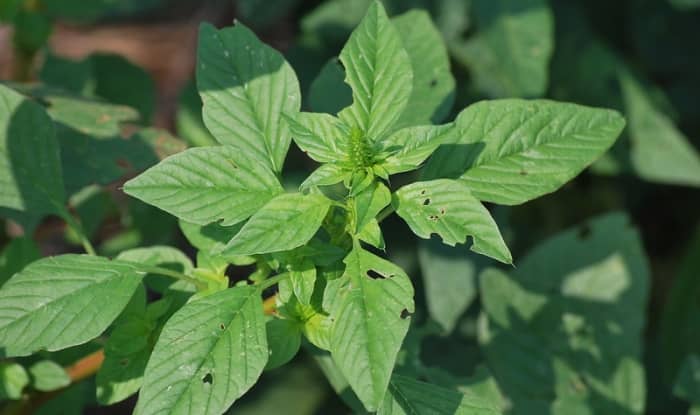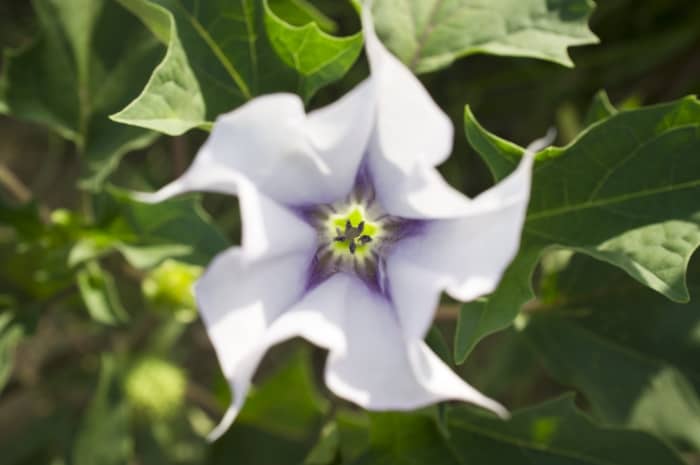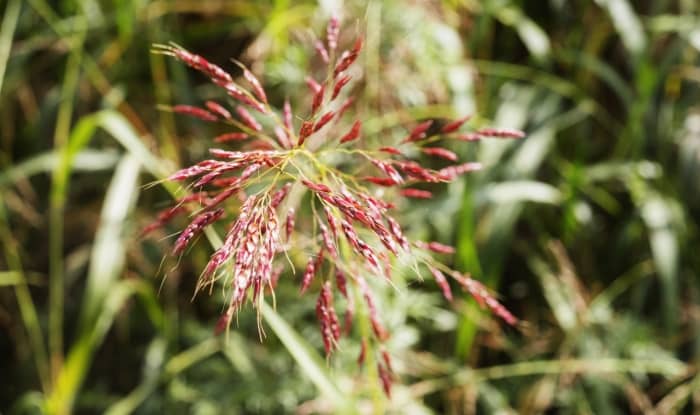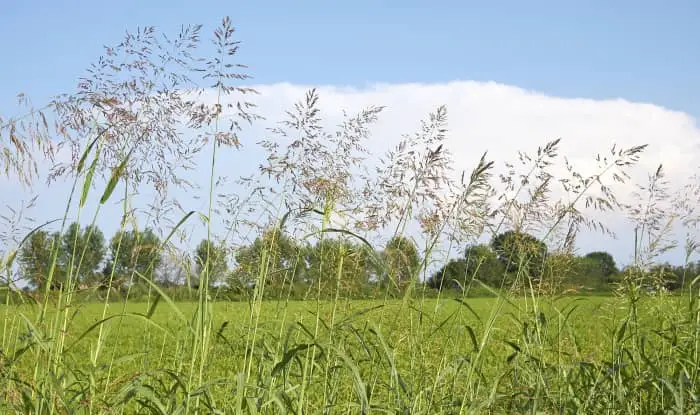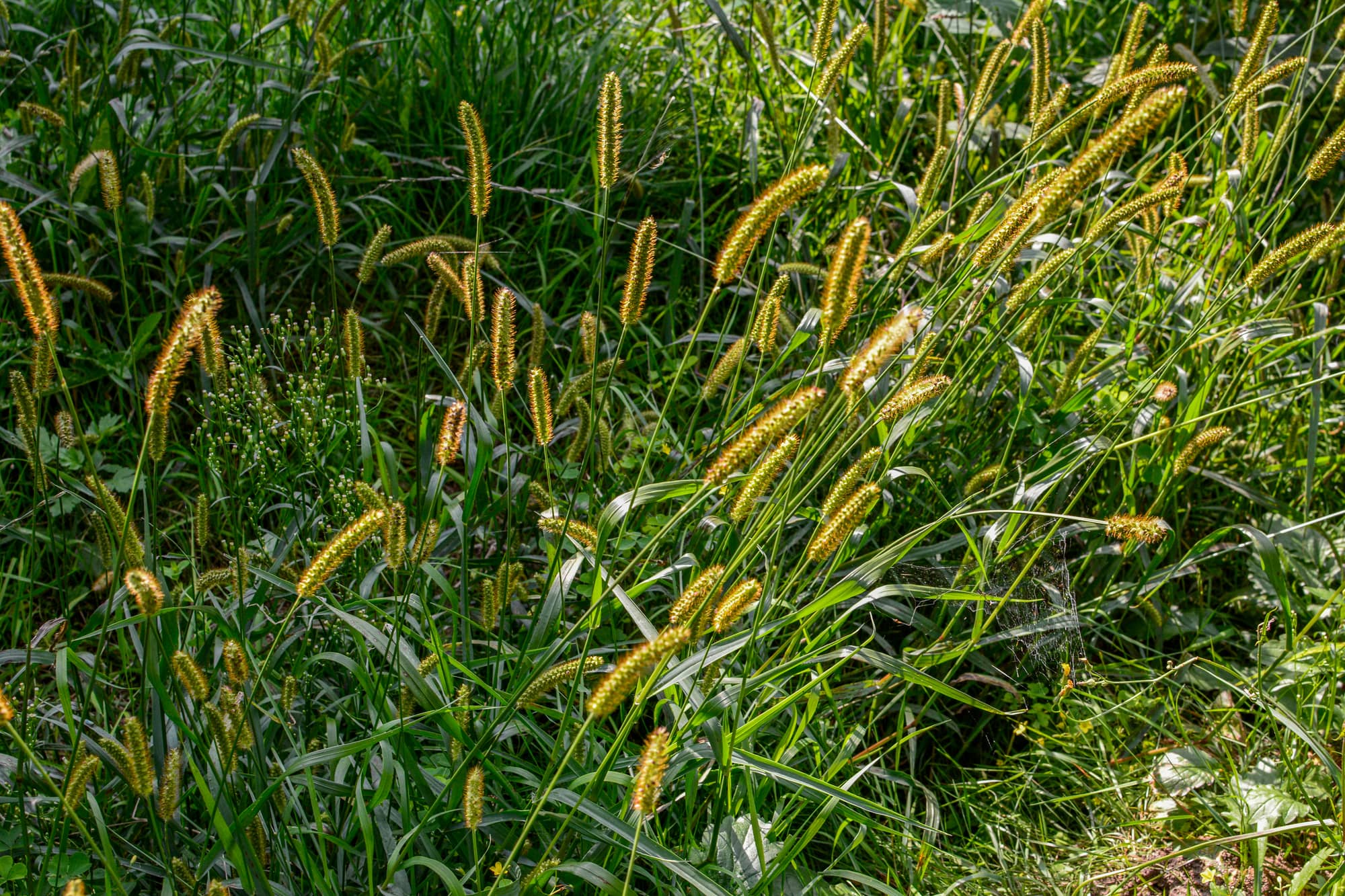Are you struggling with weeds on your farmland?
Farm weeds reduce crop yields and harvest efficiency, and it’s important to identify them so you can choose an effective method of weed control.
We’ll help you make the correct identification with photos, descriptions, and botanical names.
Let’s dive in.
Common Farm Weeds
The following are some of the most problematic and common types of farm weeds:
Palmer Amaranth (Amaranthus palmeri)
AMARANTHUS PALMERI IN THE FIELD BY UNITED SOYBEAN BOARD
Also called Palmer pigweed and careless weed, Palmer amaranth is a summer-annual weed native to the southwestern United States that has since spread to the midwest and other parts of the country.
This bad farm weed can grow over 10 ft. tall and towers above crops such as soybeans, corn, and cotton, causing an extensive loss in some areas.
The green leaves grow alternately around the stem in a symmetrical arrangement and are oval to diamond-shaped. Some leaves have a distinctive white mark, but not all plants have them.
AMARANTHUS PALMERI LEAVES BY THE UNIVERSITY OF DELAWARE
Palmer amaranth is particularly difficult to eradicate from farmland due to its ability to develop herbicide resistance, making it one of the most troublesome weeds in the country (1).
Palmer amaranth is a member of the pigweed family. Many other pigweed pants are common farm weeds, including redroot pigweed and smooth pigweed.
Common Cocklebur (Xanthium strumarium)
Common cocklebur is a summer annual broadleaf weed. The plant blooms in late summer to early fall, producing small green flowers in spiny bracts.
Shortly after pollination, the flowers disappear, and the egg-shaped fruit develops into a woody burr. The burrs are covered in hooked prickles with 2 curved spines at the tip. And they easily attach to your clothes or animal fur.
Common cocklebur grows from 2-4 feet tall. The round central stem is speckled purple and coated in short white hairs.
Leaves grow alternately and can reach 8-inches long and 6-inches across. Each leaf has shallow lobes and a sandpaper texture on the upper surface. Reddish-green petioles covered in white hairs connect the leaves to the central stem.
Young common cocklebur weeds release chemicals into the soil that prevent other plants from germinating and growing nearby, helping them to become established.
It’s common to find this weed growing in crop fields, and it’s one of the most competitive weeds in soybeans.
Another closely related weed you may come across is spiny cocklebur. The main difference from common cocklebur is the sharp spines on its stems.
Giant Ragweed (Ambrosia trifida)
GIANT RAGWEED BY FRANK MAYFIELD
Giant ragweed is a noxious weed species native to North America. Giant ragweed is a tall weed that grows up to 12 feet, outcompeting other plants in the area by preventing them from receiving sunlight as it towers above them. Because of its size, giant ragweed can be very destructive to plant life when it moves into an area.
One giant ragweed plant per square 10 ft. can reduce corn yield by 55% and soybean yield by 52% (2).
Giant ragweed has large lobed leaves with jagged edges that can measure 12-inches across. The weed has thick green or reddish stems that are rough and sometimes have a covering of fuzzy white hairs. The upper stem ends in a spike of yellow flowers that hang in clusters.
AMBROSIA TRIFIDA BY PATRICK ALEXANDER
Giant ragweed spreads through seeds, producing spiky burs that catch on animal fur and clothing or wash away with water. The weed is well-known for causing allergies, producing fine pollen that affects hay fever sufferers.
Common Mullein (Verbascum thapsus)
Also called great mullein and woolly mullein, common mullein is a giant weed that grows over 7 ft. tall. The common mullein plant has large grey-green leaves that are thick and oval-shaped. A fuzzy covering of woolly hairs gives the mullein leaves a velvety texture. The leaves grow from 4-12 inches long and 1-5 inches wide.
Common mullein is a biennial weed. In the first year the plant grows a basal rosette of furry leaves. And in the second year, the weed develops a tall stem. Common mullein flowers from June to September. With small yellow flowers clustering in a long spike at the top of the stem.
Originally native to Europe, Asia, and North Africa, great mullein is an invasive weed in many parts of North America and Australia.
Jimson Weed (Datura stramonium)
Also known as thorn apple and devil’s snare, Jimson weed is an invasive weed and a member of the nightshade family.
Because it’s a summer-annual weed, Jimson weed grows at the same time as your crops, using up nutrients that your plants need for growth. And it produces alkaloids that can prevent nearby plants from growing.
Jimson weed produces a large fruit encased in a spiky capsule. But be careful not to eat it. Jimson weed is a well-known poisonous weed that’s dangerous when ingested. And just touching the plant can cause a rash.
Jimson weed is a large weed that grows up to 6.5 ft. tall. The leaves have wavy margins and toothed edges and grow alternately from green stems that are sometimes purple-tinged.
The plant blooms in summer. With trumpet-shaped violet or white flowers up until the first frost.
Lambsquarters (Chenopodium album)
Also known as white goosefoot, lambsquarters is a common summer annual broadleaf weed in the US and Canada. You’ll often see it growing in NY State.
Lambsquarters is a very competitive weed that causes 48% yield loss in sugar beet with one plant per foot of row, 25% yield loss in soybeans with under one plant per foot of row, and 12% yield loss in corn with one plant per 1.5 feet of row (3).
You can identify this farm field weed by its velvety leaves that have a covering of wooly hairs. The leaves are small, gray-green in color, and triangular-shaped to lance-shaped with wavy edges. The weed grows from several inches to 5 ft. tall with a single central stem that sometimes has side stems.
The plant usually blooms from July to September, with clusters of tiny yellow-green flowers at the end of the stems. Occasionally lambsquarters blooms early in the season.
In the past, lambsquarters was grown for its edible and highly nutritious leaves. But the practice has fallen out of favor due to the viral diseases the weed harbors.
Lambsquarters spreads by seed after the plant flowers in late spring or early fall, so try weed removal before then. It’s fairly easy to pull lambsquarters out of the ground as it only has a short taproot.
Velvetleaf (Abutilon theophrasti)
Velvetleaf is a large farm weed with big velvety leaves that grows up to 8 ft. tall. The weed has heart-shaped leaves that are green and covered in short hairs, making the leaf soft to the touch and giving rise to its descriptive name.
In the summer, the plant produces 5-petalled, orange-yellow flowers that grow up to1-Inch in diameter from the leaf axils on short stalks.
You’ll find velvetleaf growing in agricultural fields, where it causes particular problems in cotton, corn, and soybeans, harboring viruses and pests that affect the crops.
In some states, velvetleaf is considered a noxious weed. It’s a very competitive plant that takes nutrients and water out of the soil, preventing crops from getting sufficient quantities and reducing their yield. Because of its size, the weed also blocks sunlight from reaching developing plants.
Velvetleaf can be hard to get rid of. The seeds stay dormant in the soil for a long time. They’re brought to the surface when land is disturbed. And sprout when soil becomes warm enough in the spring.
Morning Glory Vine (Ipomoea)
The name morning glory refers to a number of closely related plants, many of which are summer annual broadleaf vines. Morning glory spreads through seeds and regrows yearly but reseeds so successfully that you probably won’t notice.
The plant is well-known for its trumpet-shaped flowers that grow in clusters of 2-5 and come in many colors. You can find morning glory vines with white, purple, pink, blue, red, orange, and sometimes bi-colored flowers. The flowers bloom from June to November.
The leaves grow alternately along the vine and are usually heart-shaped. The leaves grow 3-5 inches long and are sometimes glossy.
Morning glory vines rapidly spread in hot weather. A mature plant can quickly grow vines 15 ft. tall, with the stems twisting around each other to strengthen and support the plant’s growth.
Some people like to plant morning glory as a groundcover or aesthetic enhancement for fences and barriers. But because it grows fast, morning glory can quickly become an invasive vine, spreading into yards nearby, growing over all surfaces, and harming plants.
Once established, morning glory can be very hard to get rid of, often requiring the use of powerful chemicals to kill the weed.
Morning glory is considered one of the most problematic weeds in soybean fields in the United States.
Black Nightshade (Solanum nigrum, Solanum ptycanthum, Solanum americanum)
There are three closely related plants called black nightshade in North America, sharing similar characteristics:
- European black nightshade (Solanum nigrum), also called blackberry nightshade, is native to Eurasia and an introduced species in other parts of the world.
- American black nightshade (Solanum americanum), also called glossy nightshade, is native to the Americas, Melanesia, and Australia.
- Eastern black nightshade (Solanum ptychanthum), also called West Indian black nightshade, is native to North America. This weed grows in all US states apart from Oregon, Nevada, California, and Washington State. You can also find it growing in the southern provinces of Canada.
The black nightshades are broadleaf, annual weeds with small black-purple berries that grow in clusters. The weeds have leaves that grow alternately on short stalks.
Some strains of black nightshade are poisonous plants, while others are edible weeds. The plants also resemble deadly nightshade, so unless you know what you’re doing, make sure you don’t eat the juicy berries or other parts of the plant.
You’ll often find black nightshade growing in cultivated areas, where it competes with crops and causes problems with the harvest.
Johnsongrass (Sorghum halepense)
Johnsongrass is a fast-growing perennial weed native to Asia and North Africa, now found on all continents as an introduced species. Many US states list Johnsongrass as a noxious weed.
As the name suggests, Johnsongrass is a grass-like weed. It grows up to 7 ft. tall and spreads through seeds and a system of rhizomes, growing in dense stands.
The leaves have a flat blade, are hairless to sparsely hairy, and can grow up to ft. long. The midvein is white and prominent.
From May to October, Johnsongrass produces dark reddish flowers that grow in large, well-branched flower heads.
In the fall, Johnsongrass develops large spreading seed heads with many yellow to purplish seeds.
Johnsongrass is an invasive weed that thrives on disturbed ground and can rapidly colonize cultivated fields. The weed chokes out plants and affects crop yields. Johnsongrass has become a particular problem in California cotton fields (4).
Barnyardgrass (Echinochloa crus-galli)
Also called cockspur grass, panic grass, and watergrass, barnyardgrass is a summer-annual weed native to tropical Asia that’s an introduced species in the United States.
Barnyardgrass grows up to 5 ft. tall. The leaf blades are flat, coarse, hairless on the upper surface, and grow from 2-6 inches long. In the fall, barnyard grass has reddish-purple coloring on the stems, turning brown after the frost arrives and the weed starts to die.
Barnyardgrass reproduces by seed, with the seed heads becoming visible on the weed from July to September growing in panicles. When young, the seed heads are green and develop a reddish-purple tinge as they mature.
Barnyardgrass is well-known for invading irrigated rice paddies, crop fields, and pastures. You’ll also find this weed in disturbed areas such as roadsides, ditches, and landscaped areas.
Green Foxtail (Setaria viridis)
Also known as wild millet, green bristlegrass, and pigeongrass, green foxtail has distinctive green ‘foxtails’ of seeds that resemble bristles on the end of its grass-like stalks.
It grows tall, anywhere from 10cm to 100cm. And it’s common to see in meadows and prairies.
Green foxtail is an invasive weed species. And each foxtail contains hundreds of seeds that spread easily through the air. The plant can quickly become problematic in an area.
Because green foxtail grows in all soil types, it’s a very common weed in all agricultural areas, thriving in heavily fertilized fields but often struggling to compete against densely growing crops.
Crabgrass (Digitaria sanguinalis)

Crabgrass is an invasive weed that looks similar to grass. Only, unlike the rest of your lawn, its coarse texture, thick blades, and lateral growth cause it to stand out and look unsightly.
It’s a common annual weed that germinates, grows, and dies within a year. But what it does during that year can have long-term consequences for your lawn.
Crabgrass plants produce up to 150,000 seeds. And when they die, these seeds are left behind, ready to germinate in spring the following year, leading to a weed infestation.
Like many weeds, if you leave crabgrass to grow, it will crowd out and smother plants and grass as it takes over.
It’s common to find crabgrass growing around farms in disturbed soil, as well as in orchards, vineyards, nurseries, landscaped areas, and turf.
Quackgrass (Elymus repens)

Also known as common couch, this invasive weed spreads quickly due to prolific underground rhizome growth. But the weed also reproduces from seeds, which disperse through the air and germinate further away.
Quackgrass is a common weed in row and forage crops, and infestations can reduce yields.
It’s easy to identify:
Firstly, quackgrass is a tall grass that quickly develops large patches.
And secondly, the leaves are broader than most lawn grasses and feel rough when you run your fingers across them.
You can try to dig quackgrass out, but it can be difficult. The roots break easily. And you have to make sure you don’t leave them behind because the weed will grow back.
Field Bindweed (Convolvulus arvensis)
Field Bindweed is sometimes called morning glory because it has similar-looking trumpet-shaped flowers that can be white, light pink, or sometimes both.
Field bindweed is a perennial broadleaf weed. This invasive vine weed is an aggressive grower that quickly develops slender stems up to 6 ft. long, climbing over trees, walls, fences, and along the ground.
The plant has smooth, arrowhead-shaped leaves connected to the stem by petioles. Mature leaves near the beginning of the stem are larger than the leaves at the end of the stem.
Field bindweed spreads by rhizomes, stems, and roots, and produces seeds that remain viable in the soil for 20 years or more. Once the vine weed becomes established, it’s very hard to eradicate. And it quickly outcompetes plant species growing in the invaded area.
Field bindweed can be a major problem when it invades agricultural land, as it can reduce yields by up to 60% (5).
The vine grows in a variety of conditions, in full shade and full sun, and is drought tolerant. You’ll often see field bindweed growing in farmland, forested parks, greenbelts, ravines, and gardens.
Annual Bluegrass (Poa annua)
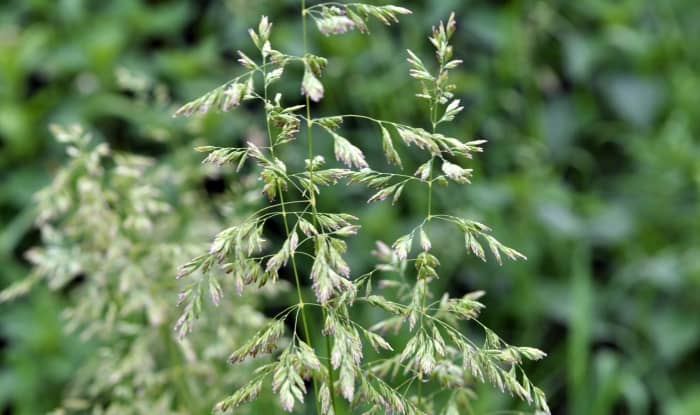
Also called Poa annua, annual bluegrass is a bright green grassy weed that grows in clumps and features smooth leaves with pointed tips.
Annual bluegrass usually germinates in late summer or early fall. The newly sprouted seedlings grow through the fall and then flower when spring arrives. It then produces a short seed head before dying off in the hot summer.
Annual bluegrass is a problem for agriculture when it invades fields growing vegetables and small grain crops. The weed also invades pastures that have been overgrazed or heavily trampled.
Broad-Leaved Dock (Rumex obtusifolius)
BROAD-LEAVED DOCK BY SCIZOFORM
Also known as bitter dock, broad-leaved dock is an invasive perennial weed. Growing up to 60-inches tall, you can identify the weed by its green, broad leaves. The leaves are oval-shaped with a rounded tip and can grow up to 16-inches long. If you look closely, you should see way edges and a reddish tinge to the stems.
If you find broad-leaved dock growing on your farm, it’s a good idea to remove it before it sets seed. Each plant produces up to 80,000 seeds that can survive in the soil for decades, sprouting each year when the conditions are right.
Broadleaf Plantain (Plantago major)
Broadleaf plantain is also called white man’s foot – a name given to it by Native Americans who associated the plant with the settlers.
It’s a perennial broadleaf weed often seen around farmland and other areas of disturbed soil and a common garden weed.
You can recognize broadleaf plantain by its big leaves that grow in a rosette. Flower stems grow vertically from the center of the weed and feature clusters of tiny greenish-brown flowers at their tips that bloom from June to September. The leaves are oval-shaped, smooth, and grow up to 20 cm long.
You can eat the highly nutritious leaves of broadleaf plantain. But think carefully before allowing this weed to grow in your garden. Each plant produces up to 20,000 seeds. And they can survive in the soil for a long time. So even after you get rid of the plant, plantain will keep appearing in your yard for many years.
Downy Brome (Bromus tectorum L.)
Also called downy chess, drooping brome grass, thatch grass, and cheatgrass brome, downy brome is a winter-annual grass that can sometimes be a summer annual.
Downy brome is an aggressive weed that threatens winter and spring crops, particularly causing problems in wheat fields.
BROMUS TECTORUM BY ANDREAS ROCKSTEIN
Downy brome grows between 4-24 inches tall and is covered in soft hairs. The weed has flat, slender, green blades with pointed tips. Inflorescences grow in oat-like panicles that are often shiny and purplish.
The weed has a shallow root system, so it’s easy to remove by hand.
Another similar weed species that causes problems is field brome (Bromus arvensis L.).
Field Sandbur (Cenchrus longispinus)
Also called burgrass and spiny sandbur, field sandbur is a summer annual grass weed.
Field sandbur is a troublesome weed in pastures and hay meadows. At maturity, the weed develops spiky burrs that can cause injury to grazing cattle and livestock. The burrs contain seeds and stick to fur, hair, and clothing, enabling the weed to spread.
CENCHRUS LONGISPINUS BY MATT LAVIN
The plant has erect or spreading stems that grow up to 1.5 ft. tall with flat green leaves. The plant often has a spreading growth, forming large mats that reach 2 ft. in diameter. The burs grow in clusters of around 20-50 at the end of stems.
Reference:
- Palmer Amaranth The King Of Weeds Criiples New Herbicides – https://cen.acs.org/business/specialty-chemicals/Palmer-amaranth-king-weeds-cripples/97/i31
- Giant Ragweed – https://www.canr.msu.edu/weeds/extension/giant-ragweed
- Common Lambsquarters – https://www.canr.msu.edu/weeds/extension/common-lambsquarters
- Johnsongrass – http://ipm.ucanr.edu/PMG/WEEDS/johnsongrass.html
- Field Bindweed – https://www.nwcb.wa.gov/pdfs/Bindweed_factsheet_King.pdf


